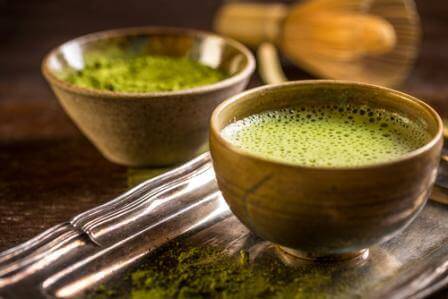What Are the Health Benefits of Matcha?
Are there any health benefits to matcha? What can this trendy superbrew do for you?
Monica Reinagel, MS, LD/N, CNS
Listen
What Are the Health Benefits of Matcha?
 Marcia writes:
Marcia writes:
“I am reading a lot about matcha. Is this just another superfood fad or is it for real? And if it is a good thing, how do you determine whether matcha is good quality?”
Matcha may be a bit of a trend right now, but it’s been around for centuries. And while it’s not going to torch body fat, kill cancer, detoxify your organs, or lower your cholesterol (as some of the websites out there claim), it does contain many beneficial compounds.
The word ‘matcha’ is Japanese and it refers to a particular way of processing and consuming green tea. Green tea that is grown for matcha is covered with cloths for several weeks before harvesting, which stimulates chlorophyll production and makes the leaves even brighter green.
The leaves are then harvested, steamed, and dried, as they are for tea. But instead of steeping the dried leaves in hot water to make tea, the leaves are ground into a fine powder. The traditional matcha beverage is made by adding a teaspoon or so of this bright green powder into a small amount of water and whisking it until is frothy. Matcha powder can also be added to foods such as noodles, muffins, and even ice cream.
What Does Matcha Taste Like?
The flavor of matcha is quite a bit more intense than traditionally brewed green tea—in part because each serving contains a lot more tea. It shouldn’t taste fishy, metallic, or unpleasantly bitter (which are signs of poor quality matcha powder). But even at its best, it can be a bit of an acquired taste.
Although price isn’t an infallible guide to quality, I would be suspicious of very inexpensive matcha. Good quality matcha will be very bright—almost electric green—in color and have a pleasant grassy or vegetal fragrance. One good description I found described it as similar to the smell of freshly pureed peas. As for the flavor, some people describe it as savory, almost like a broth. Matcha is sometimes mixed with milk or sweeteners to make it more palatable.
What’s the Difference Between Matcha and Green Tea?
Matcha contains the same nutrients and active compounds as green tea. The big difference is that you’re actually consuming the entire leaf rather than steeping and straining the leaves out of your tea. That means you get a much bigger dose of all those active compounds, including the caffeine.
Depending how much matcha powder you use, a serving of matcha may contain almost as much caffeine as an 8 oz cup of coffee. Matcha also contains a compound called theanine, which has been shown to promote a state of relaxed alertness or focus. Many people find that the theanine seems to mellow the effect of the caffeine, giving them a nice lift without the jangly buzz.
Matcha also gives you a more concentrated dose of catechins—antioxidants thought to be responsible for many of the health benefits of green tea, which include reduced risks of heart disease, cancer, and osteoporosis.
We shouldn’t assume, however, that getting a more concentrated dose of catechins will multiply those effects.
As I’ve talked about before, taking in ten times more antioxidants doesn’t usually provide ten times the benefit. There’s a threshold beyond which you get no additional benefit—and that threshold is a lot lower than most people realize.
See also: Can You Get Too Many Antioxidants?
Does Matcha Promote Weight Loss?
Almost every matcha-selling website I reviewed cited a study that supposedly found that drinking matcha will help you burn up to 43% more calories every day. If that were true, you could expect start losing a couple pounds a week just by drinking matcha.
I finally tracked down this study, which was published in the American Journal of Clinical Nutrition in 1999. It did not actually involve matcha. It used a green tea extract that contained the same amount of catechins and caffeine that you’d get from a serving of matcha.
The subjects (all ten of them!) took this extract three times over the course of a single day and the researchers measured how many calories they burned during that 24 hours. Six of the ten subjects burned more calories when they took the green tea supplement than when they took a placebo. (That means that four of the ten subjects didn’t.) And for those who did burn some extra calories, it amounted to an average of 78 calories. At that rate, it would take you about two months to lose one pound. Unless you’re in the 40% of people who get no benefit.
I honestly don’t know how these numbers got twisted into a 40% increase in calorie burn but it’s always a fascinating exercise to trace such claims to their source!
Are There Any Concerns?
Green tea leaves may contain a significant amount of lead if the plants are grown in soil with high lead levels. When you brew tea the traditional way, discarding the leaves before drinking it, the amount of lead that makes it into your cup is fairly small. But with matcha, because you’re consuming the entire leaf, you could be taking in a significant amount of lead. This is mostly a concern with tea grown in China, where lead contamination of the soil is more common. Tests done by Consumer Lab suggest that matcha produced in Japan is likely to be a safe bet. If you’re interested in trying matcha, I’d suggest buying it from a vendor that specializes in good quality tea rather than your local discount store.
Do You Enjoy Matcha?
Is matcha something that you’ve tried or incorporated into your daily routine? Have any tips or matcha recipes to share? Post them below or on the Nutrition Diva Facebook page.

